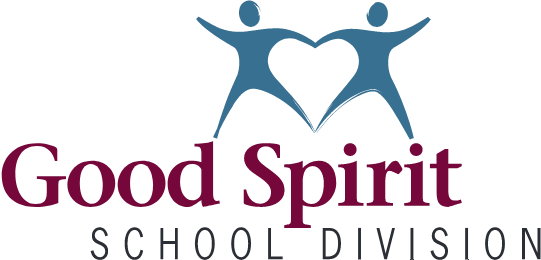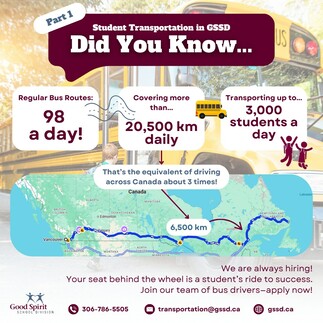
We’re kicking off a 4-part series on Student Transportation in GSSD! Today, we’re starting with Part 1—some fast facts about our daily operations.
Did you know…
- GSSD has 98 regular bus routes run every school day
- Over 20,500 km traveled daily – that’s like driving across Canada nearly 3 times!
- Up to 3,000 students transported each day
At Good Spirit School Division, student safety and accessibility come first. Our efficient transportation system ensures funding is used responsibly—while always putting students at the center.
Remember…we’re always hiring! Your seat behind the wheel is a student’s ride to success.
Apply today and join our amazing team of bus drivers!
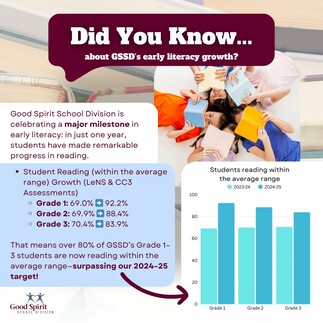
GSSD is celebrating an Early Literacy Milestone Achieved!
Good Spirit School Division is celebrating major growth in Grades 1–3 reading achievement — and we’ve surpassed our 2024–25 target!
Students Reading (within the average range) Growth (LeNS & CC3 Assessments):
• Grade 1: 69.0% -> 92.2%
• Grade 2: 69.9% -> 88.4%
• Grade 3: 70.4% -> 83.9%
That means over 80% of GSSD Grade 1–3 students are now reading within the average range!
This success comes from strong partnerships with Dr. George Georgiou (University of Alberta) and Dr. Matthew Kierstead (Alberta principal), teacher training in the five pillars of literacy, targeted interventions, and data-informed strategies—all grounded in the science of reading.
And we’re not stopping here! The 2025-26 school year will bring:
- Grade 2 intervention research project
- Expanded supports for Grades 4–6
- Ongoing Professional Development for teachers
Because every child deserves the best chance to become a skilled, confident reader.
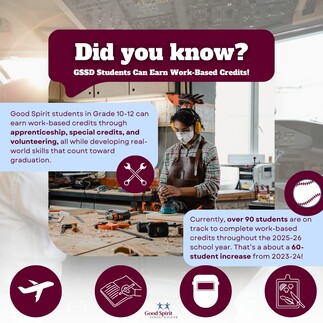
Did You Know…Good Spirit students in Grade 10-12 can earn work-based credits through apprenticeship, special credits, and volunteering, all while developing real-world skills that count toward graduation.
Currently, over 90 students are on track to complete work-based credits throughout the 2025-26 school year. That’s about a 60-student increase from 2023-24!
Examples of Apprenticeship credits include:
• Carpenter
• Heavy Duty Mechanic
• Welder
• Plumber, and more!
Examples of Special Credits:
• 4H projects
• Cadets
• Author a book
• Advanced Volleyball/Baseball/Lacrosse
• Obtaining a pilot's license, and more!
Placements of Volunteerism Credits include:
• Local Cafeterias
• Local Community Organizations (church groups, elementary schools)
• Coaching Hockey
• Care Homes, and more!
This growth shows how students are embracing opportunities to connect learning with life beyond the classroom.
To learn more on how yourself or your student can earn Work-Based Credits, contact your school, and check out the following Admin Procedures for further details:
- 251 Apprenticeship Credits (September 2024)
- 252 Volunteerism Credit (May 2024)
- 253 Special Project Credit (updated September 2024)
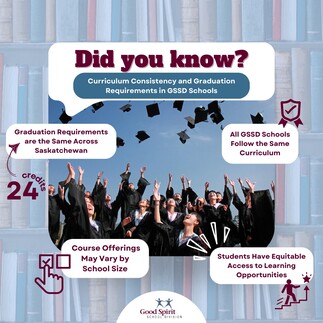
Did you know…
In GSSD, all students—no matter which school they attend—follow the same curriculum and graduation requirements as every other student in Saskatchewan. The Ministry of Education sets these standards to ensure consistency and fairness across the province.
Graduation Requirements: All high school students must complete 24 credits. This ensures that a diploma from any school in Saskatchewan reflects the same academic standards.
Curriculum Consistency: Whether a student attends a larger urban school or a smaller rural school, they’re learning the same core content. Saskatchewan’s curriculum is standardized.
Course Offerings: Larger schools tend to offer more electives and specialized programs. Smaller schools may have fewer course options but often provide more personalized support due to fewer students per teacher.
Equitable Access for All:
-Students can enroll in online courses through the Saskatchewan Distance Learning Corporation (SaskDLC).
-Dual credit and apprenticeship programs give high school students a head start on post-secondary education and trades.
-Special Project Credits allow students to pursue personal interests or career exploration under teacher supervision.
No matter where students go to school, GSSD supports them in building strong foundations for bright futures.
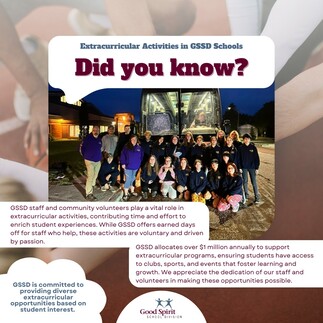
Did you know...GSSD invests over $1 million each year into extracurricular programs—and it’s our incredible staff and community volunteers who bring them to life! From clubs to sports and special events, these opportunities wouldn’t be possible without their passion and dedication.
Thank you for going above and beyond to support student growth beyond the classroom!
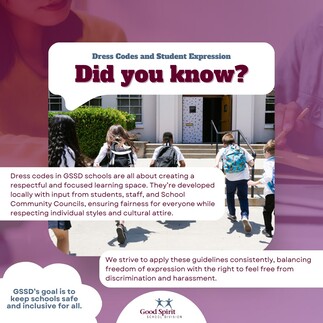
Dress codes in GSSD aren’t about limits—they’re about respect and belonging.
Created with input from students, staff, and School Community Councils, our guidelines support individuality and help create safe, focused learning spaces for everyone.
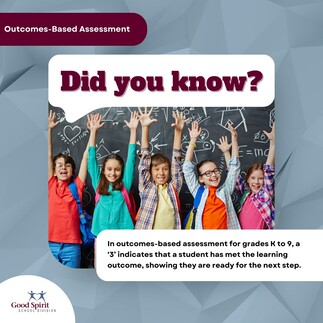
Did You Know?
In outcomes-based assessment for grades K to 9, a ‘3’ indicates that a student has met the learning outcome, showing they are ready for the next step!
Grade 10-12 curricula are also outcome-based, and teachers are required to follow the curriculum developed by the Ministry of Education.
While outcomes are not reported on a 1-4 scale, all high school assessments are based on achievement of outcomes.
For more information on Assessment and Reporting, check out our website at:
https://www.gssd.ca/.../curricul.../assessment-and-reporting
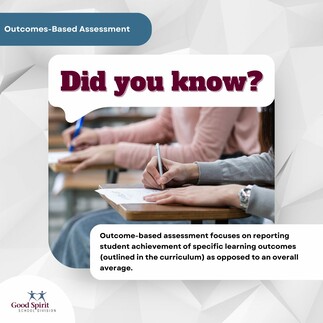
Did You Know? Outcomes-Based Assessment:
- Focuses on reporting student achievement of specific learning outcomes (outlined in the curriculum) as opposed to an overall average. This provides more detailed information about what a student is learning and how they are progressing.
- Focuses only on achievement of the outcome. Other factors affecting student achievement (behaviour, participation, homework completion etc) are reported separately.
- Allows students to demonstrate their learning in a variety of ways.
- Involves students in the assessment process by providing information on the learning outcomes and how they will be assessed.
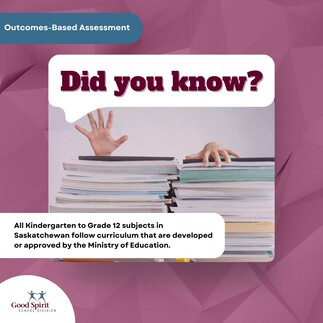
Did You Know?
All Kindergarten to Grade 12 subjects in Saskatchewan follow curriculum that are developed or approved by the Ministry of Education. These curricula are broken down into outcomes.
Outcomes define what a student is expected to know and be able to do at the end of the grade or Secondary Level course. Teachers gather evidence on an ongoing basis in order to understand individual student’s learning based on conversations, observations and products.
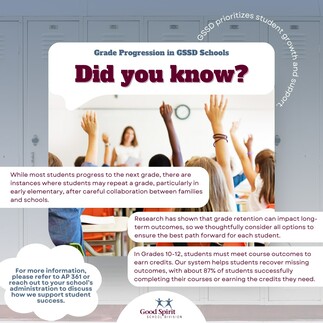
Grade progression is thoughtfully considered to ensure every student has the support they need to succeed. Whether it's collaborating in early elementary or helping high school students recover credits, we’re here to prioritize student growth and support.
Learn more about how we support students in achieving success: refer to AP 361 or connect with your school administration.
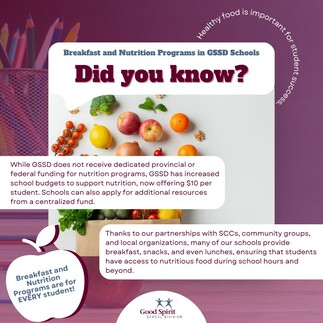
We are grateful to be able to offer Breakfast and Nutrition programs in GSSD!
These programs are available to every student within a school, and we want to thank everyone who makes these programs possible!
While GSSD does not receive dedicated provincial or federal funding for nutrition programs, GSSD has increased school budgets to support nutrition, now offering $10 per student. Schools can also apply for additional resources from a centralized fund.
Thanks to our partnerships with SCCs, community groups, and local organizations, many of our schools provide breakfast, snacks, and even lunches, ensuring that students have access to nutritious food during school hours and beyond.
Breakfast and Nutrition Programs are for EVERY student!
